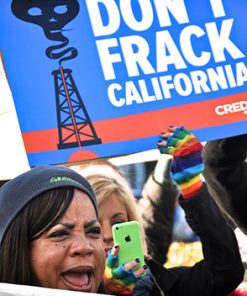“We must electrify one billion machines across 121 million households in the coming years. It’s an ambitious goal, making this the decade of electrification. But the Inflation Reduction Act will help us achieve it: It gives every household a sum of money to electrify their home over the next ten years.” — Rewiring America
By shifting from fossil fuels to clean electricity powered by renewable sources, societies can reduce greenhouse gas emissions, improve energy efficiency, and create resilient, future-proof economies.
The result of burning fossil fuels is literally all around us: wildfires raging hotter, hurricanes growing fiercer, and heatwaves turning cities into outdoor saunas. The solution isn’t complicated. It’s elegantly simple: electrify everything.
Not just cars, homes and power plants. Everything. Offices, factories, transportation systems, even leaf blowers and lawn mowers. If it burns fossil fuels, it can (and should) be replaced by an electric alternative powered by clean energy. This isn’t a futuristic fantasy; it’s a strategy already underway in places that recognize the stakes.
Why electrify everything? Because electricity, when sourced from renewables like solar, wind, and hydro, can be carbon-free. Fossil fuels, on the other hand, are inherently dirty. Even the “cleanest” natural gas plant emits carbon dioxide. No amount of marketing can change the basic chemistry. The faster we replace fossil fuel combustion with clean electricity, the faster we slash emissions.
Cities are leading the charge. Berkeley, California, was the first in the U.S. to ban natural gas hookups in new buildings. New York followed with legislation requiring new constructions to be all-electric. This isn’t just climate policy—it’s public health policy. Gas stoves emit nitrogen dioxide, carbon monoxide, and other pollutants right into our kitchens. Electrification means cleaner air both outside and inside our homes.
Transportation is the next frontier. The goal isn’t just cars—it’s electric buses, trucks, trains, and even ferries. In Norway, over 80% of new car sales are electric. China has more than 400,000 electric buses in operation. The shift is happening, but it needs to accelerate. Why? Because transportation is the largest source of carbon emissions in many countries.
What about heavy industry—the factories, refineries, and cement plants that traditionally guzzle fossil fuels? Electrification can decarbonize many industrial processes. Electric arc furnaces in steel production, for example, are already common and far cleaner than traditional blast furnaces. Green hydrogen, produced using renewable electricity, can replace fossil fuels in processes where direct electrification isn’t feasible.
Of course, electrification is only as clean as the grid powering it. That’s why this strategy goes hand-in-hand with decarbonizing the power sector. Globally, renewables are now the cheapest source of new electricity generation in most regions. Solar and wind are scaling rapidly, and battery storage is addressing the intermittency challenge, making 24/7 clean power a reality.
But can the grid handle everything being electrified? Yes, with upgrades. The grid will need to be modernized to accommodate increased demand, distributed energy sources, and smart technologies. This isn’t a problem; it’s an opportunity. Grid modernization creates jobs, improves reliability, and enables a more resilient energy system.
The economic case for electrification is compelling. Electric technologies are often more efficient and cheaper to operate over time. According to a 2021 report from Rewiring America, electrifying U.S. households could save the average family $1,500 per year in energy costs.
Equity is crucial. The benefits of electrification—clean air, lower energy bills, healthier homes—must be accessible to everyone, not just the wealthy. Policies should prioritize investments in low-income communities, offer subsidies for electrification retrofits, and ensure that renters and marginalized populations aren’t left behind. Programs like California’s Equity Resilience Incentive provide financial support for vulnerable households to adopt clean energy technologies.
Globally, electrification is gaining momentum. The European Union’s Green Deal aims to achieve climate neutrality by 2050, with electrification at the core of its strategy. In Australia, the state of Victoria has banned new gas connections, focusing on electric heating and cooking. Developing countries are leapfrogging traditional fossil fuel infrastructure, moving directly to clean, distributed energy systems.
Financing is critical. Governments can incentivize electrification through tax credits, grants, and low-interest loans. The International Energy Agency estimates that achieving net-zero emissions by 2050 will require $4 trillion annually in clean energy investments. While that sounds daunting, the costs of inaction—climate disasters, health impacts, and economic disruptions—are far greater.
Behavioral change complements technology. Public awareness campaigns, energy literacy programs, and community engagement can accelerate adoption. When people understand the health, financial, and environmental benefits of electrification, resistance
diminishes, and momentum grows.
Policy coordination is essential. Electrification cuts across sectors—energy, housing, transportation, industry—requiring integrated strategies. National climate plans, local ordinances, and international agreements must align to create a coherent frame
work for action.
Cultural shifts matter. The image of “progress” has long been tied to fossil fuels—power plants belching smoke, highways packed with gas-guzzling cars. Electrification redefines progress as clean, efficient, and sustainable. It’s not about sacrifice; it’s about living better with less harm to the planet.
Therefore, under Folklaw:
Electrification shall be prioritized across all sectors—transportation, buildings, industry, and agriculture—powered by renewable energy.
Governments will invest in grid modernization, renewable energy expansion, and electrification infrastructure. Policies will support the transition from fossil fuels, including incentives for electric technologies, subsidies for low-income households, and workforce retraining programs.
Building codes will mandate electric heating, cooling, and appliances in new construction, with retrofit programs for existing buildings.
Support for research and development in energy storage and smart grid technologies will be strengthened. International cooperation will promote best practices and accelerate the global transition to an electrified economy.






Discussions
There are no discussions yet.